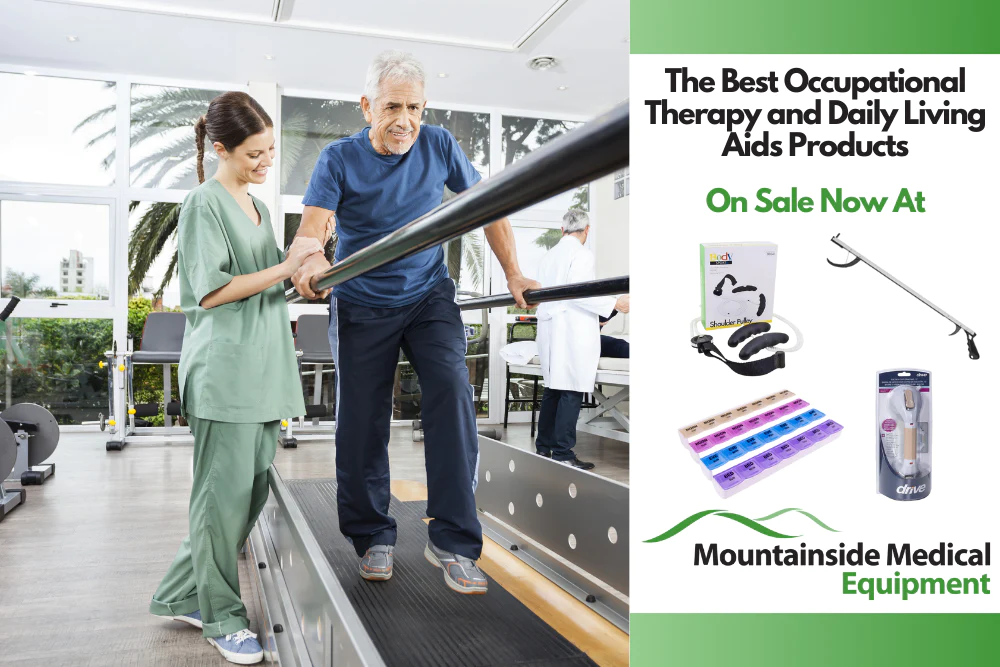April is Occupational Therapy Month, celebrating a discipline that can make radical improvements in the lives of patients, but one that's not fully understood. Many people consider occupational therapy (OT) to be the same as physical therapy (PT), but while they overlap the two practices have specific, different goals.

Occupational Therapy (OT)
Occupational therapy (OT) focuses on helping you perform day-to-day tasks, tailored to your specific workplace and home environment. It focuses on making common daily activities and motions easier through assistive technology and environmental adjustment.
So what kind of people can OT benefit? Occupational therapists have a wide range of patients, including those with:
- Traumatic brain or spinal cord injuries
- Degenerative diseases
- Sensory processing disorders
- Autism or other developmental conditions
- Mental and behavioral health problems
- Birth injuries or defects
- Any other type of injury or disorder that can impact someone's ability to perform everyday tasks
Benefits of OT
-
Adaptive Strategies and Equipment: Occupational therapy is about finding ways to improve an individual's daily life by adapting it to their needs. Sometimes this means finding adaptive strategies such energy conservation strategies for those with significant fatigue, whether emotional or physical. Sometimes this also means the use of adaptive equipment: assistive devices such as reacher arms, sock aids, and shoehorns; mobility devices like wheelchairs and walkers; safety and balance equipment like grab bars, raised toilet seats, and tub transfer benches. It could even mean something as common as an electric can opener or jar opener for people with weak manual dexterity.
-
Improved Visual Skills: People with diminished or altered sight from eye disease, brain injury, or stroke can learn adaptive strategies like scanning movements and pre-reading.
-
Occupational Therapy Exercises: Sometimes OT crosses over with PT, as some patients are well-served by stretching techniques and manual guided exercises to reduce pain, improve weak joint movement, and compensate for weakness in an extremity.
-
Improved Range of Motion: Many OT patients have loss of motion from injury, stroke, or surgery, and occupational therapists can help them mitigate this through both passive and active range of motion exercises; teaching proper body positioning to reduce resistance and improve ease of mobility; and teaching compensatory prevention techniques to help improve movement while building strength.
-
Home Safety Assessments: An occupational therapist can do a thorough analysis of a patient's home environment to find environmental factors that can make their daily life more difficult or even hazardous, and then make adjustments to make their home more comfortable and safe.
-
Caregiver Training: OTs can help train a patient's loved ones in caring for them, so that they can better understand and assist the patient. This is particularly common for the loved ones of patients with dementia or other degenerative diseases, stroke, or even those on the autism spectrum.

Physical Therapy (PT)
Physical therapy provides a safe, effective alternative pathway to pain relief. It involves the use of exercise, soft tissue mobilization, muscle stimulation, hydrotherapy, and other methods to strengthen the body, improves range of motion, and restores function while providing pain relief that can lessen dependence on medication.
Benefits of Physical Therapy
Physical therapy is a complex discipline that can be utilized as part of a recovery or rehabilitation program for any number of conditions.
-
Pain Management: Manual therapy techniques, as well as therapeutic exercises and treatments, to relieve pain, break down scar tissue, and restore joint function and motion to reduce pain.
-
Improved Mobility: Identification of specific issues affecting movement. Strengthening exercises and stretching to rebuild muscle and increase joint range of motion. Proper fitting for an assistive device.
-
Improved Balance: Screening for fall risks. Coordination and balance exercises, as well as techniques that reduce vertigo symptoms and restore inner-ear balance.
-
Managing Diabetes and Vascular Conditions: Exercise to control blood sugar. Foot and wound care to manage the effects of poor circulation to the legs, as well as therapies to improve circulation.
-
Aging Management: Exercises and techniques to help manage the effects of arthritis and osteoporosis, as well as joint pain and replacement.
-
Avoiding/Recovering from Surgery: Strengthen muscles and rebuild range of motion after surgery. Pre-surgery physical therapy to ease recovery or avoid surgery altogether.
-
Recovery from Stroke or Heart Attack: Regain strength, balance, coordination, and control of movement.
-
Sports Injury Prevention and Management: Design plans for injury recovery or prevention tailored to the demands of a particular sport.
Physical therapy has something to offer anyone, and this is possibly its greatest strength: adaptability. The ability to meet each individual patient's needs with therapy plans created alongside the patient not only creates better outcomes, but also allows more autonomy and independence for a patient with a serious injury or chronic condition.

Whether you're living with a brain disorder or cautious about fall and injury risk, Mountainside Medical Equipment has what you need! We've got everything from mobility devices to safety bars to assistive devices like reachers. Click this link to visit our mobility products, and click here to visit our daily living aids collection!
Please consult your doctor or other qualified medical professional before stopping or starting any medications, supplements, or health regimens.


Leave a comment